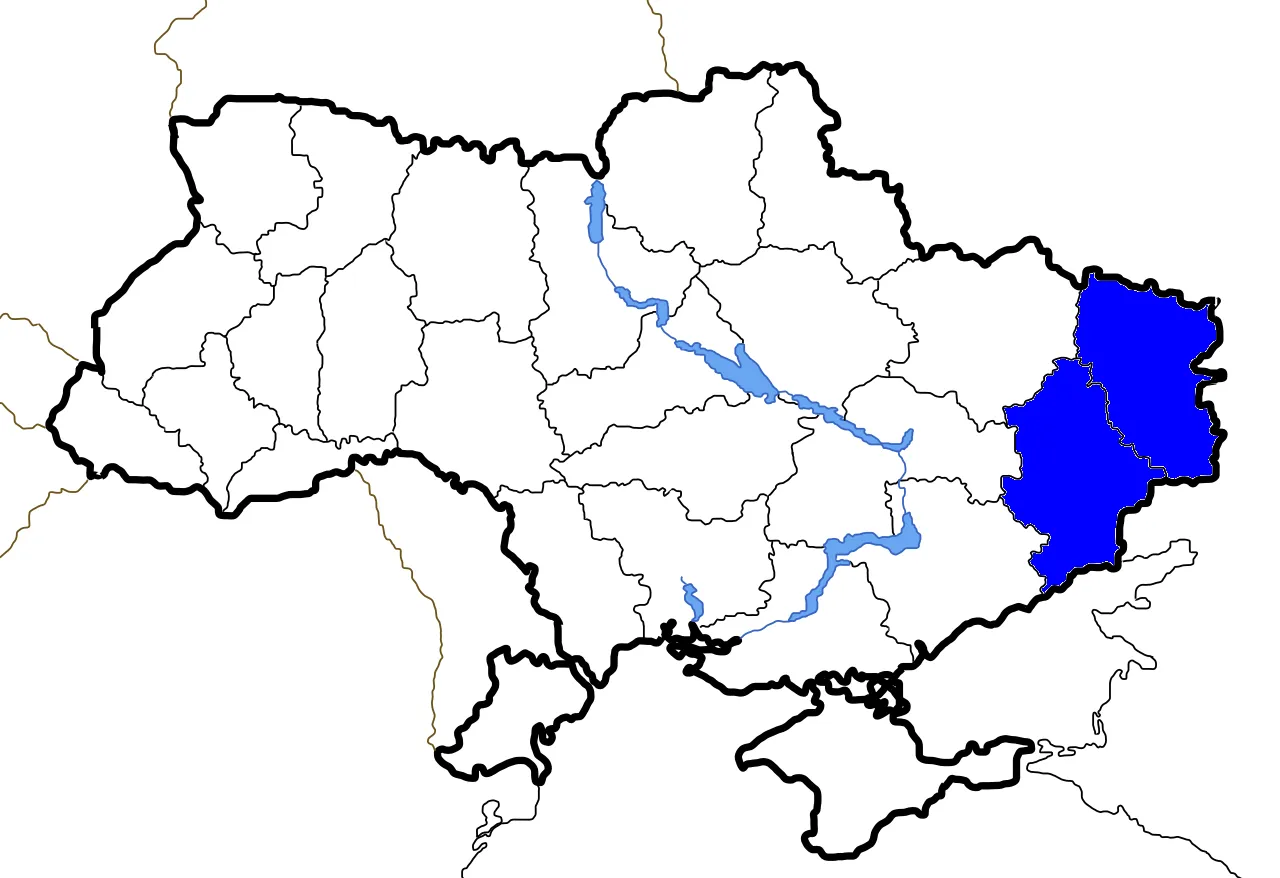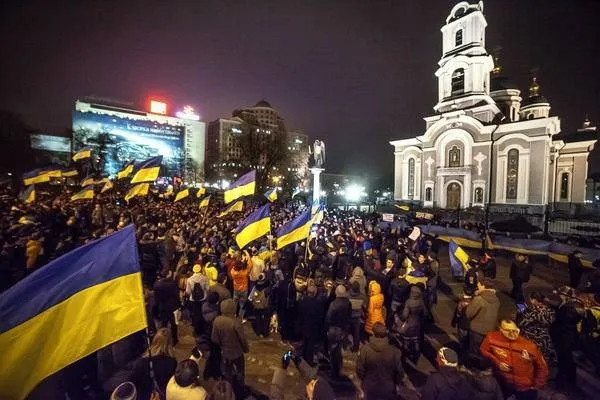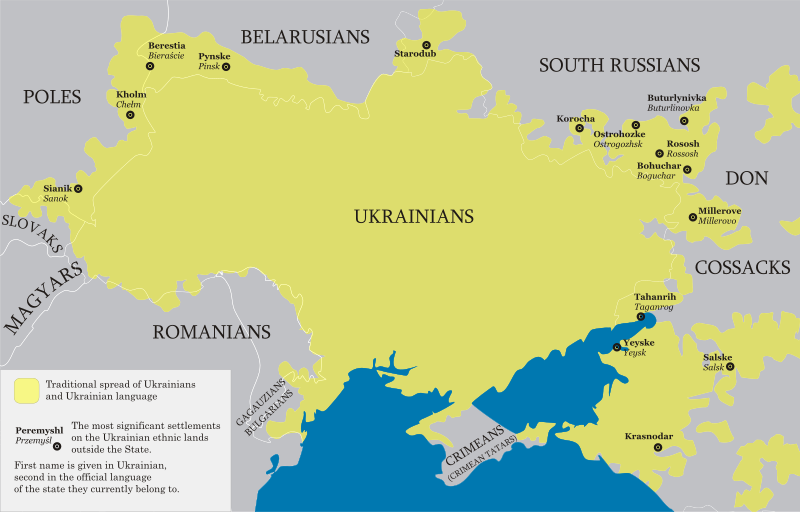Donbas is Ukraine
You may hear Russian propaganda telling you that Donbas is a Russian territory and that oppressed Russians live there, therefore Russia helps them. There are too many wrongs in these statements. I discussed some these claims in the other articles (I will provide links below), but now I want to concentrate on the claim that Donbas is not a “real Ukraine”. Donbas is indeed Ukraine, politically, ethnically and historically.
First things first, Donbas is a collective name for two Ukrainian eastern regions — Donetsk and Luhansk, famous for their coal mines and related industry.

For those of you who prefer emotional arguments: this is a photo[1] from the last pro-Ukrainian rally in Donetsk which happened already after the first shots in Donbas:

For those of you who love anecdotes — I personally know a person from Luhansk who fled to safer parts of Ukraine, speaks Ukrainian and hates Russian invaders. Also my grandmother was from Luhansk region, she identified as Ukrainian, even though she usually spoke Russian, and she disliked Russians even before the 2014 invasion.
For those of you who prefer statistics, please read on.
In 1991 there was a referendum in Ukraine about independence. Both Donbas regions voted YES [2] [3] with a majority of votes (more than 83%).
In 2001 there was a census of Ukrainian population and 57% of Donetsk and 58% of Luhansk regions identified as Ukrainians [4].
In 2014 there was a sociological research [5] on whether they wanted to join Russia, similar research was repeated in 2021 [6]. Both researches show that majority of Donbas population did not want to join Russia. In Donetsk percentages of those who wanted to join Russia were 28% in 2014 and 10% in 2021. Same numbers for Luhansk were 30%/12%. Please note — there was indeed a big support for joining Russia in 2014, but it was not a majority.
People in Donbas do indeed speak Russian, and comparing to other regions majority of Donbas chooses Russian as a mother tongue [7]. Numbers are 69% for Luhansk and 75% for Donetsk. Kharkiv and Zaporizhzhia, closest contestants, are at 45% and 48% respectively. Please be warned — Russian propaganda often use this language statistics to prove that people in Donbas support joining Russia. And that is a trap I don’t want you to fall into. As an obvious example — both Irish and Americans speak English, but this does not mean they want to join England.
For those who like history, northern Donbas was part of Sloboda Ukraine [8]. And here is a map of Ukrainian speakers from the beginning of 20th century [9]:
 Ukrainian speakers in the beginning of 20th century (by Riwnodennyk)
Ukrainian speakers in the beginning of 20th century (by Riwnodennyk)
Or may check another, more detailed, ethnic Ukrainian map, end of 19th century [10]:
 Blue — clear Ukrainian majority, grey — significant Ukrainian population (the more — the darker, percentages of Ukrainians are shown with the letter У), map compiled by Роман Днепр
Blue — clear Ukrainian majority, grey — significant Ukrainian population (the more — the darker, percentages of Ukrainians are shown with the letter У), map compiled by Роман Днепр
For those who point out the results of pro-Russian referenda in 2014 and 2022 — these were fake. Any numbers could be written in the results, since no one checked. Good examples are referenda in Kherson and Zaporizhzhia and they were absurd and showed clearly false numbers — I discuss it in the articles linked below. Donetsk and Luhansk referenda were just as fake.
So Donbas is a historically, ethnically and politically a Ukrainian region. Most of population never wanted to join Russia and all Russian talks about Donbas being a “Russian region” are plain lies.
Sources and related articles follow:
[1] An article about last pro-Ukrainian rally in Donetsk (in Ukrainian) https://armyinform.com.ua/2020/04/28/28-kvitnya-2014-roku-%E2%88%92-ostannij-proukrayinskyj-mityng-u-doneczku/
[2] Wikipedia article about 1991 referendum: https://en.wikipedia.org/wiki/1991_Ukrainian_independence_referendum
[3] Other source with numbers (look for Donetsk and Luhansk): https://www.electoralgeography.com/new/en/countries/u/ukraine/ukraine-independence-referendum-1991.html
[4] Archive copy of 2001 census: http://web.archive.org/web/20220316164419/http://2001.ukrcensus.gov.ua/eng/results/general/nationality/
[5] 2014 KIIS research: https://www.kiis.com.ua/?lang=eng&cat=reports&id=1138&page=2
[6] 2022 KIIS research: https://www.kiis.com.ua/?lang=eng&cat=reports&id=1127&page=4
[7] Language statistics: http://web.archive.org/web/20220314083057/http://2001.ukrcensus.gov.ua/eng/results/general/language/
[8] https://en.wikipedia.org/wiki/Sloboda_Ukraine
[9] https://en.wikipedia.org/wiki/Geographical_distribution_of_Ukrainian_speakers
[10] https://commons.wikimedia.org/wiki/File:1897%D0%A3%D0%BA%D1%80%D0%BF%D0%BE%D0%B2%D1%96%D1%82%D0%B8.png